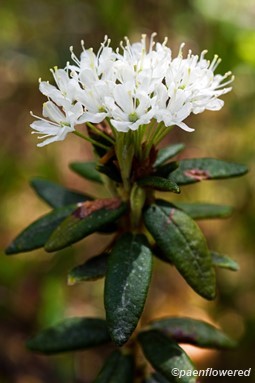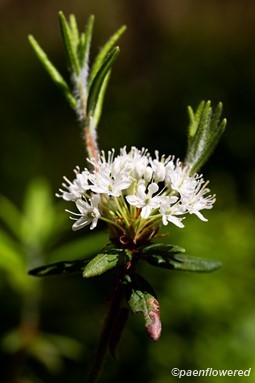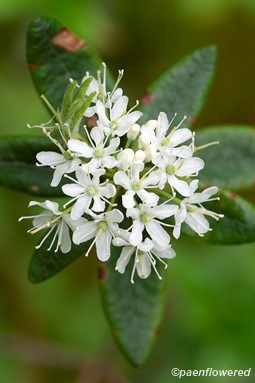Rhododendron groenlandicum
A low-growing evergreen shrub with fragrant leaves and clusters of white fragrant flowers
Rhododendron groenlandicum bog Labrador tea
Add to MyPlants View Locations
Bog Labrador tea is a low-growing evergreen shrub, reaching 1–3 feet tall, commonly found in cool, wet habitats such as bogs, swamps, and muskegs across the northern United States, Canada, Alaska, and Greenland. Its fragrant white or pink-tinged flowers bloom in clusters at the branch tips, just before shoot elongation, attracting a variety of pollinators, including bumblebees, bees, flies, beetles, moths, hummingbirds, and sawflies - with bumblebees as the primary pollinators.
The shrub’s distinctive evergreen leaves, which curl under along the edges, cluster densely on the upper parts of the branches, creating a compact, aromatic foliage. Historically, its leaves were brewed into Labrador tea by Indigenous peoples and early settlers, though it can be toxic in high concentrations.
Habitat & Range
Rare in bogs and peaty wetlands. Prefers partial shade and acidic, nutrient-poor soils rich in organic matter.
Present in north-east and north-west of the state. See distirubtion map at BONAP.
Range: Across North America and Greenland, extending through Canada, northern US, and Alaska.
| EMP: | OBL |
|---|---|
| NCNE: | OBL |
Phenology
Flowers in late May through June. Blooms from 2 to 4 weeks.
Characteristics
Inflorescence terminal clusters of 10 to 40 flowers
Flowers regular, 5-merous; corolla white with 5 oval petals; 5 to 10 stamens around green ovary
Leaves alternate, with one leaf at each node; enitre, elliptic, revolute (rolled under); tapered or blunt at ends; upper surface dark green and smooth to slightly hairy, lower surface with densely white to rusty-wooly
Stems upright, woody, densely hairy; become smoother with age
Fruit fuzzy, oval, 5-celled capsule, abt ¼″ long; splitting upward from the base
Bark gray, can peel or shed with age
Twigs densely rusty-wooly when young; become smoother, grayish brown with age
Buds have 3 or more overlapping scales
Height 1-3 feet
Age long-lived, can persist for decades
Fall Color green, may be with yellow or brown hues
Plant Codes
PA-status: PT (Threatened)
S-rank: S3 (Vulnerable)
G-rank: G5 (Secure)
Ecology
Palm Warblers use the stems as nest material while butterflies rely on the nectar. The plant is a larval host for the Northern Blue butterfly. Bumble bees are the main pollinators.
During the winter months, deer and moose feed on the leaves if no other food is available.
APG/Taxonomization Info
Labrador tea had long been classified as part of the genus Ledum, but been reclassified as part of the Rhododendron species in the 1990s.
Rhododendron groenlandicum bog Labrador tea
Synonyms: Ledum groenlandicumAdd to MyPlants View Locations









Comments
Have you spotted this plant in your area? We'd love to hear about your experience! Share your comments or questions about the plant below. Comments are moderated before posting.